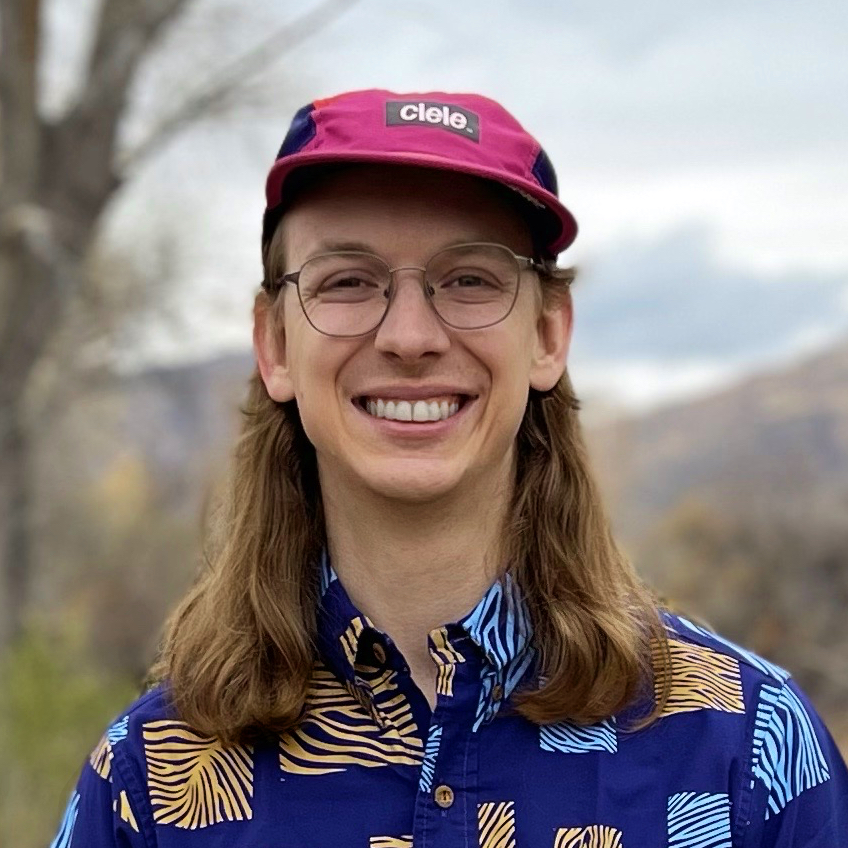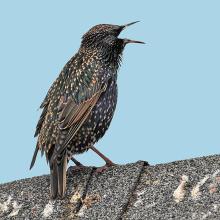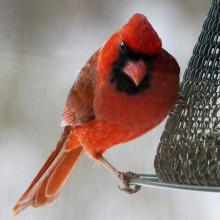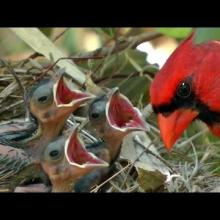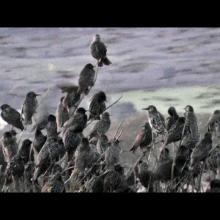

Join BirdNote tomorrow, November 30th!
Illustrator David Sibley and actor H. Jon Benjamin will face off in the bird illustration battle of the century during BirdNote's Year-end Celebration and Auction!
For National Poetry Month, we’re sharing contemporary writers’ work about birds. Poet Susan Nguyen got a hummingbird feeder from her neighbor in 2020 during the COVID pandemic. She began taking an interest in the hummingbirds that visited, giving them names and learning the surprising way they use their tongues to drink nectar. The way birds defy expectations has helped inspire several of Susan’s poems.
Murmuration
I wake to starlings on the roof like rain.
How they arrived here is still a mystery.
Urban legend claims a Shakespeare lover
brought every bird in his litany to North America.
Watching the dusk swell with their flight,
I choose to believe this myth. Twisting and retreating,
they move in a continuous mass. We know all it takes
is one. The seven around him follow,
and then the seven around them, until they surge like a wave.
When they spiral, it’s effortless – like the whirlpools
we anchored as children. One kid would start, then two.
Then suddenly, wordlessly, it was all of us walking single
file around the kiddie pool, watching the center of the storm.
In another place, a starling’s murmuration obliterates the sky.
Hundreds crescendo above their roost each evening,
then collapse in sleep. Migrate to escape cold climate.
Mom says I’m like a bird too. The way I leave,
then return, then leave.
BirdNote®
Poetry Month: Susan Nguyen
Written by Mark Bramhill
Mark Bramhill: This is BirdNote.
It’s National Poetry Month in the US, and we’re celebrating by sharing contemporary writers' work about birds. Poet Susan Nguyen didn't start thinking about birds much until 2020, when the COVID pandemic began.
Susan Nguyen: I was home all the time, as many of us were. and my neighbor gave me their extra hummingbird feeder. And we kind of had a competition, just to see like, oh, which one are they going to go to?
Mark Bramhill: Susan took to naming some of her regulars, like Clementine or Jelly-Belly. And watching these birds brought a kind of peace.
Susan Nguyen: It was a little bit of magic happening every day outside my window during a time I think that was pretty difficult.
Mark Bramhill: As Susan began researching her new feathered friends, she learned how much these birds defy our expectations. Like, for almost two centuries, scientists believed that hummingbirds tongues worked through capillary action. But in 2015...
Susan Nguyen: They found out like they've been wrong this entire time — their tongues do not work like a straw, it works differently. And I just thought that was incredible that we went that long just assuming, like, yeah, of course, that's how their tongues work, you know? And then someone actually observed them, like, just set up a camera and were like, “this is not what I'm seeing,” right, and it was so much more recent.
Mark Bramhill: Learning about these tiny, glittering marvels wound up inspiring a poem:
Susan Nguyen:
In Praise of a Hummingbird’s Tongue
So long it coils around their small skulls. A forked miracle that traps nectar — collects it in the beak and forces it to the back of the throat. That’s where the hum begins. Flicks in and out and again. Something about surface tension: how a dead hummingbird’s tongue in nectar will drink repeatedly. A flock of live hummingbirds is a bouquet of white bellies, humming. Something about how hard it is to stay still, be an absence of sound. I name each bird as they float at my feeder. A glittering of green, the way they fan their tail feathers. The way they divebomb each other through the notes of their body’s hum. So small a marvel. But back to the tongue, back of the throat. Anything but the absence of miracle.
Mark Bramhill: Susan’s writing often begins grounded in memory and experiences, and blooms out from there. Like this next poem, about her relationship with her mother.
Susan Nguyen:
Impossible Deer
When I visit Virginia in winter,
Mom says she’s been seeing prints
on our snow-covered deck.
Deer, she tells me. I laugh.
Deer can’t jump that high.
Maybe opossum or raccoon.
But she doesn’t know what those
are, not my English words
for them. And I don’t know
how to translate. I’m frustrated
now — at how often our conversations
go like this: faltering, me punishing
her with silence for not understanding,
How my first instinct towards
my mother is never kindness.
Who am I to tell her what is possible?
Just this morning looking out
from the deck, I saw the fire
of eight cardinals burning
in our honeysuckle. An omen.
Maybe that was my mother too.
One landed on the snow bright
as a radish, as the pendant
my mother gifted that I refuse
to wear — too showy, too loud.
My mother has already done
the impossible, making it here.
What have I done? I want to believe
that I can be someone else. A better
daughter. These are my mother’s
deer, I’ll tell everyone.
They leap into flight on cold
nights and return as red-feathered
birds, spilling across the sky.
Susan Nguyen: A lot of it is pulled just from like what actually happened. You know, my mom did see like prints on our deck, and she was like, yeah, deer. And I'm like, that's impossible, you know? And then it just made me wonder, well, what is possible and not possible?
I think it also helped me kind of get to a place where I could say something that was difficult for me to say.
Mark Bramhill: Susan has always loved nature, but growing up it wasn’t an interest she shared with her family. Reflecting more on the moment, Susan realized that her mom was telling her about the animal tracks to show she cared.
Susan Nguyen: There are prints outside, right? Like, she wanted to tell me, because for me, that would be something I'd want to know. I like that that is a moment of connection that we have.
[Music ends]
Mark Bramhill: Every poet has a different process for how they approach writing. For Susan, it tends to be a little circuitous. If she ever has a thought of “oh, I want to write a poem about this thing”…
Susan Nguyen: I'm like, immediately now I cannot write about that thing, you know? Like I can't come at it like that directly, and I wish I could.
I feel like I'm a collector. When I like notice something, I have to write it down somewhere and it might become nothing, but I don't want to forget things. Um, I think [in] one of my poems, I have a line that says, “I wake to starlings on the roof like rain.” Like, I wrote that down, probably months or maybe even years before I was able to use that line, just cause it was something that I did experience that, it felt amazing, you know? Waking up being like, it sounds like it's raining, and then looking out the window and it's like, oh, it's all these starlings landing on the roof and now they're taking off and all moving into this tree before they move on, you know?
Mark Bramhill: Here’s the poem that came from that moment:
Susan Nguyen:
Murmuration
I wake to starlings on the roof like rain.
How they arrived here is still a mystery.
Urban legend claims a Shakespeare lover
brought every bird in his litany to North America.
Watching the dusk swell with their flight,
I choose to believe this myth. Twisting and retreating,
they move in a continuous mass. We know all it takes
is one. The seven around him follow,
and then the seven around them, until they surge like a wave.
When they spiral, it’s effortless – like the whirlpools
we anchored as children. One kid would start, then two.
Then suddenly, wordlessly, it was all of us walking single
file around the kiddie pool, watching the center of the storm.
In another place, a starling’s murmuration obliterates the sky.
Hundreds crescendo above their roost each evening,
then collapse in sleep. Migrate to escape cold climate.
Mom says I’m like a bird too. The way I leave,
then return, then leave.
Mark Bramhill: Towards the end of the poem, Susan references one of the worlds’ largest starling murmurations that takes place in Denmark. It’s known as “sort sol” or “black sun” because there are so many birds that it can literally eclipse the sun.
Susan Nguyen: It can be up to like 1 million starlings a night. Like, I, my mind can actually fathom what that might look like, you know, and how that takes over the sky and darkens sunset and the sky.
[Lots of European Starlings]
Mark Bramhill: Thanks to Susan Nguyen for sharing her work. You can hear more poetry about birds on our website, BirdNote dot org. I’m Mark Bramhill.
###
Producer: Mark Bramhill
Managing Editor: Jazzi Johnson
Managing Producer: Conor Gearin
Content Director: Jonese Franklin
Bird sounds provided by The Macaulay Library of Natural Sounds at the Cornell Lab of Ornithology, Ithaca, New York. Black-chinned Hummingbird ML6113 recorded by Robert B. Angstadt, Rufous Hummingbird ML50107 recorded by Geoffrey A. Keller, Broad-tailed Hummingbird ML303538531 recorded by Andrew Spencer, Northern Cardinal ML107290 and ML84706 recorded by Wil Hershberger, European Starling ML487448001 recorded by Mark Lewis, and European Starling ML282613271 recorded by Bernard Tremblay.
Music: The Wind in High Places, II. Maclaren Summit by JACK Quartet and John Luther Adams; In the White Silence: Letter K by Tim Weiss & Oberlin Contemporary Music Ensemble; Three Birds by Belle Chen
BirdNote’s theme was composed and played by Nancy Rumbel and John Kessler.
© 2024 BirdNote April 2024
Narrator: Mark Bramhill
ID# NguyenS-01-2024-04-04 NguyenS-01


